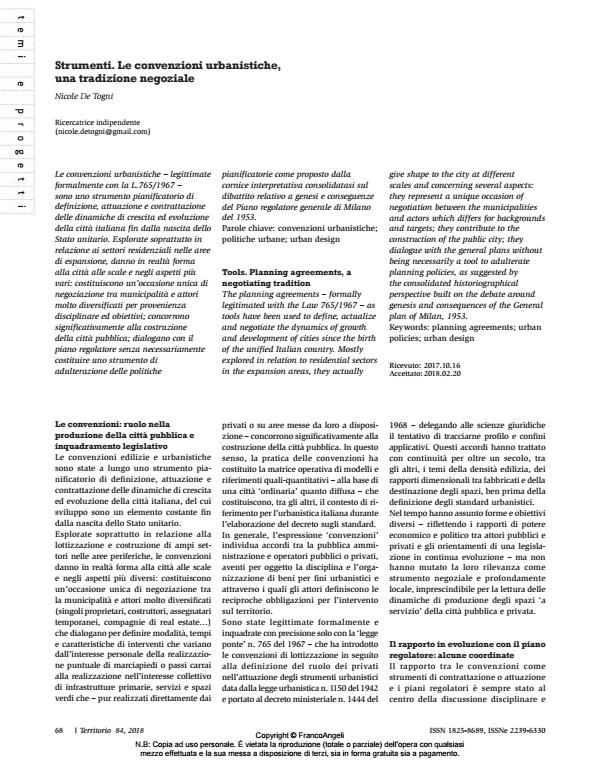Tools. Planning agreements, a negotiating tradition
Journal title TERRITORIO
Author/s Nicole De Togni
Publishing Year 2018 Issue 2018/84 Language Italian
Pages 4 P. 68-71 File size 249 KB
DOI 10.3280/TR2018-084009
DOI is like a bar code for intellectual property: to have more infomation
click here
Below, you can see the article first page
If you want to buy this article in PDF format, you can do it, following the instructions to buy download credits

FrancoAngeli is member of Publishers International Linking Association, Inc (PILA), a not-for-profit association which run the CrossRef service enabling links to and from online scholarly content.
The planning agreements - formally legitimated with the Law 765/1967 - as tools have been used to define, actualize and negotiate the dynamics of growth and development of cities since the birth of the unified Italian country. Mostly explored in relation to residential sectors in the expansion areas, they actually give shape to the city at different scales and concerning several aspects: they represent a unique occasion of negotiation between the municipalities and actors which differs for backgrounds and targets; they contribute to the construction of the public city; they dialogue with the general plans without being necessarily a tool to adulterate planning policies, as suggested by the consolidated historiographical perspective built on the debate around genesis and consequences of the General plan of Milan, 1953.
Keywords: Planning agreements; urban policies; urban design
- Zanfi F., 2013, «Convenzioni urbanistiche e nuovo paesaggio residenziale per i ceti medi a Milano tra gli anni ’50 e ’70». Territorio, 64: 66-74. DOI: 10.3280/TR2013-064011
- Vercelloni V., 1961, «Milano 1861-1961: un secolo di occasioni mancate nello sviluppo della città». Casabella Continuità, 253: 28-41.
- Tortoreto E., 1977, «La mancata ‘difesa di Milano’ dal 1945 al 1950: considerazioni sulle linee politiche della ricostruzione edilizia». Storia urbana, 1: 97-133.
- Portoghesi P., Vercelloni V., 1969, «L’occhio vuole la sua parte: l’edilizia milanese fra la quantità e la qualità». Controspazio, 2-3: 6-21.
- Patetta L., 1973, «Alcune opere recenti del professionismo milanese». Controspazio, 1: 67-98.
- Graziosi S., Viganò A., 1970, «Milano vendesi. Vent’anni di malgoverno urbanistico della città». Relazioni Sociali, numero speciale.
- De Togni N., 2015, Negoziando la città. Le convenzioni urbanistiche nel centro storico di Milano tra contrattazione e programmazione, Politecnico di Torino (tesi di dottorato).
- Caramellino G., Renzoni C., 2016, «Negotiating the middle-class city. Housing and equipping post-war Turin, 1950-1980». Cidades, Comunidades e Territórios, 33: 68-88.
- Campos Venuti G., Oliva F., 1993, a cura di, Cinquant’anni di urbanistica in Italia. 1942-1992. Roma-Bari: Laterza.
- Campos Venuti G., 1986, a cura di, Un secolo di urbanistica a Milano. Milano: Clup.
- Boatti A. 1986, «Il piano regolatore del 1953 e la sua attuazione: dall’utopia del Piano ar agli anni della speculazione». In: Campos Venuti G. (a cura di), Un secolo di urbanistica a Milano. Milano: Clup, 43-89.
Nicole De Togni, Strumenti. Le convenzioni urbanistiche, una tradizione negoziale in "TERRITORIO" 84/2018, pp 68-71, DOI: 10.3280/TR2018-084009